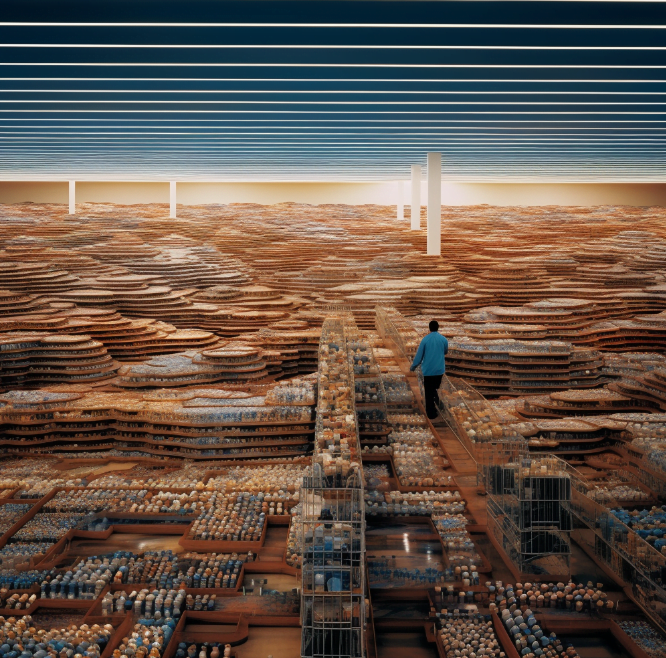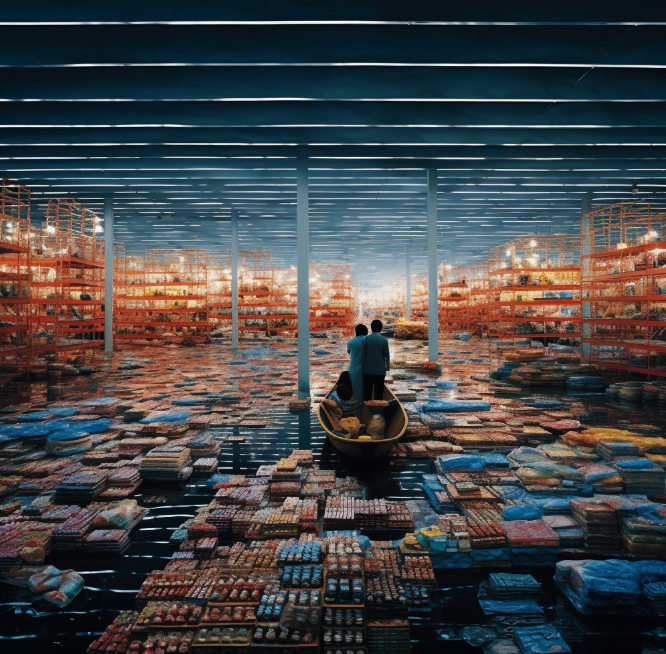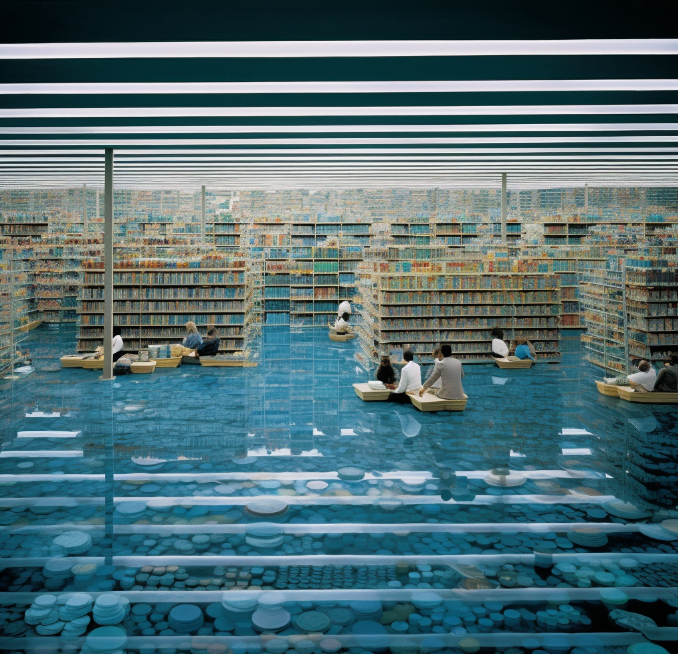Memoriesforart » Artists » Andreas Gursky
Andreas Gursky has led a life devoted to pushing the boundaries of contemporary art and photography. Through his monumental works, he has transformed mundane subjects into thought-provoking images that provide insight into the human experience in modern society.
His pioneering style and masterful use of digital manipulation have inspired countless other artists. His record-breaking prints are a testament to his vision and skill. Gursky’s enduring influence on art and his enormous commercial success have cemented his status as contemporary art’s most expensive photographer.

Andreas was born in 1955 in Leipzig, Germany. He grew up in Düsseldorf and showed an early interest in photography. Gursky received his primary education at the Folkwangschule in Essen, Germany. He then studied visual communications and photography at the Kunstakademie Düsseldorf from 1976 to 1987.
During his studies, Gursky was influenced by the teachings of influential German photographers Hilla and Bernd Becher, who emphasized a straightforward photographic style. Gursky adapted Becher’s approach to documenting industrial structures and applied it to his large-scale photographs of contemporary subjects.
Andreas Gursky is best known for his large-scale photographs of contemporary subjects that capture the effects of globalization and capitalism on society.


In the 1980s, Gursky began experimenting with digital editing techniques and wide-angle lenses to capture vast spaces in a highly detailed manner. His distinct style incorporates a bird’s-eye view and digitally manipulates his photos to create scenes that emphasize the individual within the contemporary world. His photographic works explore themes of globalization, consumerism, and contemporary existence.
Through his pioneering photography, Gursky has established himself as an influential figure in contemporary art. His monumental photographs offer a glimpse into the human experience in an increasingly globalized society dominated by capitalism and material excess. Gursky’s visually striking images will undoubtedly remain an important artistic record of life at the turn of the 21st century.

Two of his most famous works that exemplify this are Rhine II and 99 Cent.
It depicts a stretch of the Rhine River in Düsseldorf, Germany. Gursky digitally manipulated the image to remove elements like buildings and people, creating an austere and minimalist landscape.
The vast scale and hyper-realism give a sense of abstraction, reducing the location to its geometric forms and colors. Rhine II is seen as a pivotal work that demonstrated Gursky’s mastery of digital tools to accentuate the visual impact of his photographs.
Gursky again used digital manipulation to sharpen the image and add extra details to enhance the effect. The combination of abundance and uniformity gives a surreal quality. Andreas Gursky 99 cent established him as a critical observer of capitalism and globalization in the modern world.
Andreas Gursky has been the subject of major exhibitions at renowned art institutions worldwide, garnering critical acclaim and prestigious accolades.
The Museum of Modern Art, New York (2001) They hosted Gursky’s first major U.S. retrospective. The exhibition featured nearly 50 of his large-scale photographs spanning from the 1980s to 2001 and established Gursky as a pioneering figure in contemporary art photography.
Center Georges Pompidou, Paris (2007) A major retrospective in 2007 solidified Gursky’s status as one of the most important contemporary artists. The exhibition included over 60 photographs, showcasing Gursky’s stylistic evolution and range of subjects.
White Cube, London (2011) Gursky’s largest UK exhibition was held featuring new and unseen works. The show demonstrated Gursky’s continuing experimentation with scale and subject matter.
Turner Prize Nomination (1999) Gursky was nominated for the prestigious Turner Prize for contemporary art. Though he did not win, the nomination brought greater attention and critical acclaim for his pioneering photography.
Gursky has received numerous honors recognizing his monumental contributions to contemporary art. Some of Andreas Gursky’s awards are:
The Infinity Award for Art from the International Center of Photography in New York
The Kulturpreis Prize from Deutschen Gesellschaft for Photography
Erich Salomon Prize from the Deutsche Gesellschaft
As one of the most expensive living photographers, Gursky’s large-scale photographs are highly sought after by art collectors and museums around the globe. The reasons are:
Gursky only produces a limited number of prints of each photograph, sometimes as few as six. The enormous size of his prints, some over 6 feet high and 11 feet wide, also adds to their scarcity and impact.
Gursky is renowned for his large-format photographs depicting contemporary subjects like mass gatherings of people, landscapes, and architecture. His striking and thought-provoking images provide social commentary on globalization, capitalism, and the human condition. Gursky’s visually striking photographs highlighting the geometry in crowds and landscapes in a detached yet monumental way have come to define his signature style.
Gursky is a master of large-format photography and digital manipulation. His photographs demonstrate an unparalleled level of detail and clarity. Gursky will often digitally manipulate his photographs to achieve perfect symmetry and emphasize the graphic elements of his compositions. His innovative use of digital techniques was groundbreaking and highly influential.
Gursky is regarded as one of the most important contemporary photographers. His works have been exhibited in major museums around the world and studied in depth. Gursky represented Germany at the Venice Biennale, and his works have sold for record prices at auction, holding the world auction price records for a photograph in 2011.
The scarcity, size, subject matter, technical mastery, and cultural significance of Gursky’s works all contribute to their high value in the art market. As Gursky continues to gain greater historical importance, his works are viewed as a strong investment by collectors. His pieces have appreciated enormously in value, and this trend is likely to continue.
Titel: 99 Cent

A potential NFT (Non-Fungible Token) collection of Andreas Gursky’s artwork could be an innovative and groundbreaking project that combines the world of fine art with the emerging technology of blockchain and digital ownership. The collection could showcase some of Gursky’s most iconic and sought-after artworks in a new digital format, offering art enthusiasts and collectors a unique and immersive experience.
Roadmap for the NFT Collection:
Selection of Artworks: The collection would start with a careful curation of Andreas Gursky’s most famous and influential artworks. These could include his large-scale photographs of urban landscapes, crowded public spaces, and mesmerizing architectural structures.
Digitization and Enhancement: Each selected artwork would undergo a meticulous process of digitization to ensure the highest quality and detail in the digital format. Gursky’s mastery of digital manipulation would be utilized to enhance and optimize the images for a captivating digital experience.
Tokenization and NFT Minting: The digitized artworks would be tokenized into unique NFTs using blockchain technology. Each NFT would represent a one-of-a-kind digital asset, certifying its authenticity, rarity, and ownership.
Accompanying Information: Each NFT would be accompanied by detailed information about the artwork, including its title, creation date, and significance in Gursky’s body of work. This information would provide collectors with valuable insights into the artist’s vision and process.
Limited Editions: To create a sense of exclusivity and scarcity, the collection could include limited editions of certain NFTs. For instance, a specific artwork might have only a limited number of NFTs available for purchase.
Virtual Gallery Exhibition: A virtual gallery space could be designed to showcase the NFT collection. Collectors and art enthusiasts could explore the gallery in a digital environment, interacting with the artworks and experiencing the scale and intricacies of Gursky’s pieces.
Collaboration with Gursky: In an ideal scenario, Andreas Gursky himself could be involved in the creation and promotion of the NFT collection. His insights, commentary, and involvement would add immense value to the project and attract even more interest from art enthusiasts.
Community Engagement and Events: To foster a sense of community around the NFT collection, virtual events such as Q&A sessions with the artist, live discussions, and digital art workshops could be organized. This would create a platform for fans, collectors, and Gursky himself to interact and share their passion for art.
Philanthropic Aspect: A portion of the proceeds from NFT sales could be allocated to charitable causes related to art, education, or environmental preservation. This would add a philanthropic dimension to the project and align with Gursky’s contributions to the art world
By combining the artistic brilliance of Andreas Gursky with the cutting-edge technology of NFTs, the collection would offer a new way for art enthusiasts to engage with and own digital representations of his iconic works. It would be an exciting and transformative journey that pushes the boundaries of art ownership and digital expression.



Facebook: https://m.facebook.com/people/andreas-Gursky/100050628333276/
Instagram: https://www.instagram.com/andreasgurskyph/
Twitter: https://twitter.com/gurskyandreas
Foundation: http://www.hallartfoundation.org/de/artist/andreas-gursky
Website: https://andreasgursky.com/